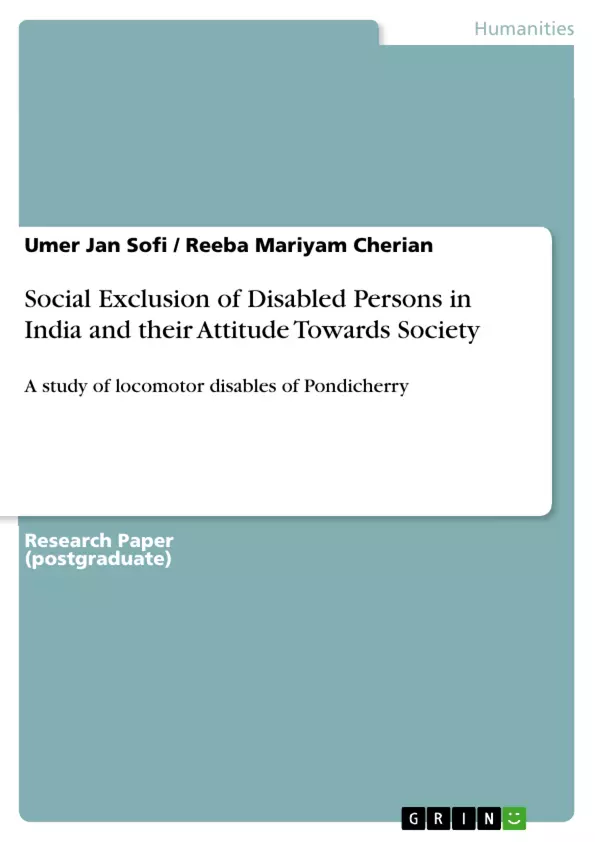
Social Exclusion of Disabled Persons in India and their Attitude Towards Society
Forschungsarbeit, 2011
77 Seiten, Note: A-
Leseprobe
Table of Contents
- Chapter One: Introduction
- Chapter Two: Review of Literature
- Chapter Three: Research Methodology
- Chapter Four: Data Analysis and Interpretation
- Chapter Five: Main Findings and Suggestions
Objectives and Key Themes
This research study aims to investigate the social exclusion experienced by disabled persons in Pondicherry, India, and analyze their attitudes towards society. The study focuses specifically on individuals with locomotor disabilities.
- Social exclusion of disabled persons in India
- Attitudes of disabled persons towards society
- The impact of disability on daily life and social participation
- Family support and its influence on the lives of disabled individuals
- The role of societal attitudes in shaping the experiences of disabled persons
Chapter Summaries
Chapter One: Introduction: This introductory chapter sets the stage for the research by defining the problem of social exclusion faced by disabled individuals in India, particularly focusing on those with locomotor disabilities in Pondicherry. It establishes the context of the study, highlighting the significance of understanding the lived experiences of this population and their perceptions of societal attitudes. The chapter likely outlines the research questions and objectives, providing a roadmap for the subsequent chapters. It may also briefly introduce the methodology employed to gather and analyze data related to social exclusion and attitudes.
Chapter Two: Review of Literature: This chapter provides a comprehensive overview of existing research and literature pertaining to the social exclusion of disabled persons, focusing on both national and international perspectives. It likely synthesizes studies on the experiences of people with disabilities, examining topics such as societal attitudes, accessibility, inclusion in education and employment, and the impact of policies. This chapter serves as a foundation for the study, positioning the current research within the broader academic conversation and highlighting any gaps in existing knowledge that the study aims to address. It will likely cover various theoretical frameworks used to analyze disability and social exclusion.
Chapter Three: Research Methodology: This chapter details the research design and methodology used in the study. It describes the population studied (locomotor disabled individuals in Pondicherry), the sampling techniques employed, the data collection methods (likely including interviews and surveys), and the analytical approaches used to interpret the gathered information. This section ensures the transparency and reproducibility of the research, allowing readers to assess the validity and reliability of the findings. It will justify the chosen methods in relation to the research questions and objectives.
Chapter Four: Data Analysis and Interpretation: This chapter presents the findings of the research, systematically analyzing the data collected through the described methodology. It will likely use statistical analyses to present demographic information and explore relationships between different variables. This chapter is crucial for understanding the specific experiences of the participants. It will likely present qualitative data from interviews and discuss trends and patterns observed in responses. This section would provide evidence related to social exclusion and attitudes toward society held by participants.
Chapter Five: Main Findings and Suggestions: This chapter summarizes the key findings of the study, drawing conclusions based on the analysis presented in Chapter Four. It will likely discuss the extent of social exclusion faced by the participants and identify factors contributing to this exclusion. It would present suggestions and recommendations for addressing the issue of social exclusion and improving the lives of disabled persons in Pondicherry, potentially including recommendations for policy changes, community initiatives, or further research.
Keywords
Social exclusion, disability, locomotor disability, India, Pondicherry, societal attitudes, qualitative research, inclusion, social participation, family support.
Frequently Asked Questions: A Research Study on Social Exclusion of Disabled Persons in Pondicherry, India
What is the main topic of this research study?
This research study investigates the social exclusion experienced by disabled persons, specifically those with locomotor disabilities, in Pondicherry, India, and analyzes their attitudes towards society.
What are the key themes explored in the study?
The study explores several key themes, including the social exclusion of disabled persons in India, their attitudes towards society, the impact of disability on daily life and social participation, the role of family support, and the influence of societal attitudes on the experiences of disabled individuals.
What is the structure of the research report?
The report is structured into five chapters: Chapter One (Introduction), Chapter Two (Review of Literature), Chapter Three (Research Methodology), Chapter Four (Data Analysis and Interpretation), and Chapter Five (Main Findings and Suggestions). It also includes a table of contents, objectives and key themes, chapter summaries, and keywords.
What does Chapter One cover?
Chapter One introduces the research problem, focusing on social exclusion faced by individuals with locomotor disabilities in Pondicherry. It establishes the study's context, outlines research questions and objectives, and briefly introduces the methodology.
What is the purpose of Chapter Two?
Chapter Two provides a comprehensive review of existing literature on the social exclusion of disabled persons, both nationally and internationally, positioning the current research within the broader academic conversation and identifying gaps in knowledge.
What information is presented in Chapter Three?
Chapter Three details the research design and methodology, including the study population, sampling techniques, data collection methods (likely interviews and surveys), and data analysis approaches. This ensures the research's transparency and reproducibility.
What are the contents of Chapter Four?
Chapter Four presents the research findings, systematically analyzing the collected data using statistical and qualitative approaches. It explores relationships between variables and discusses trends and patterns observed in participants' responses concerning social exclusion and attitudes toward society.
What does Chapter Five include?
Chapter Five summarizes the key findings, draws conclusions based on the data analysis, discusses the extent of social exclusion, and identifies contributing factors. It also offers suggestions and recommendations for addressing social exclusion and improving the lives of disabled persons in Pondicherry, including potential policy changes and community initiatives.
What are the key words associated with this research?
Key words include: Social exclusion, disability, locomotor disability, India, Pondicherry, societal attitudes, qualitative research, inclusion, social participation, and family support.
What type of research methodology was used?
The research methodology is detailed in Chapter Three, but it likely includes both qualitative methods (such as interviews) and potentially quantitative methods (surveys and statistical analysis) to comprehensively investigate the research questions.
Who is the target population of this study?
The target population is individuals with locomotor disabilities residing in Pondicherry, India.
Details
- Titel
- Social Exclusion of Disabled Persons in India and their Attitude Towards Society
- Untertitel
- A study of locomotor disables of Pondicherry
- Veranstaltung
- M.PHIL
- Note
- A-
- Autoren
- Umer Jan Sofi (Autor:in), Reeba Mariyam Cherian (Autor:in)
- Erscheinungsjahr
- 2011
- Seiten
- 77
- Katalognummer
- V273030
- ISBN (Buch)
- 9783656650546
- ISBN (eBook)
- 9783656650553
- Dateigröße
- 1666 KB
- Sprache
- Englisch
- Schlagworte
- social exclusion disabled persons india attitude towards society pondicherry
- Produktsicherheit
- GRIN Publishing GmbH
- Preis (Ebook)
- US$ 32,99
- Preis (Book)
- US$ 52,99
- Arbeit zitieren
- Umer Jan Sofi (Autor:in), Reeba Mariyam Cherian (Autor:in), 2011, Social Exclusion of Disabled Persons in India and their Attitude Towards Society, München, Page::Imprint:: GRINVerlagOHG, https://www.diplomarbeiten24.de/document/273030
- Autor werden
- Ihre Optionen
- Vertriebskanäle
- Premium Services
- Autorenprofil
- Textarten und Formate
- Services für Verlage, Hochschulen, Unternehmen

- © GRIN Publishing GmbH.
- Alle Inhalte urheberrechtlich geschützt. Kopieren und verbreiten untersagt.
- info@grin.com
- AGB
- Open Publishing
Der GRIN Verlag hat sich seit 1998 auf die Veröffentlichung akademischer eBooks und Bücher spezialisiert. Der GRIN Verlag steht damit als erstes Unternehmen für User Generated Quality Content. Die Verlagsseiten GRIN.com, Hausarbeiten.de und Diplomarbeiten24 bieten für Hochschullehrer, Absolventen und Studenten die ideale Plattform, wissenschaftliche Texte wie Hausarbeiten, Referate, Bachelorarbeiten, Masterarbeiten, Diplomarbeiten, Dissertationen und wissenschaftliche Aufsätze einem breiten Publikum zu präsentieren.
Kostenfreie Veröffentlichung: Hausarbeit, Bachelorarbeit, Diplomarbeit, Dissertation, Masterarbeit, Interpretation oder Referat jetzt veröffentlichen!
- GRIN Verlag GmbH
-
- Nymphenburger Str. 86
- 80636
- Munich, Deutschland
- +49 89-550559-0
- +49 89-550559-10
- info@grin.com
-









